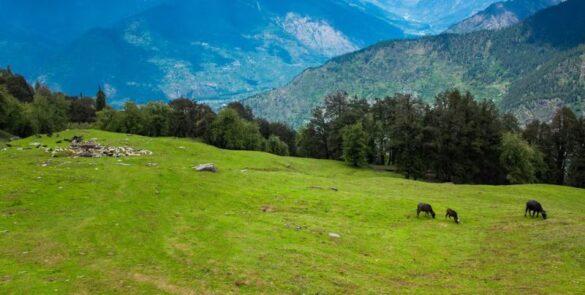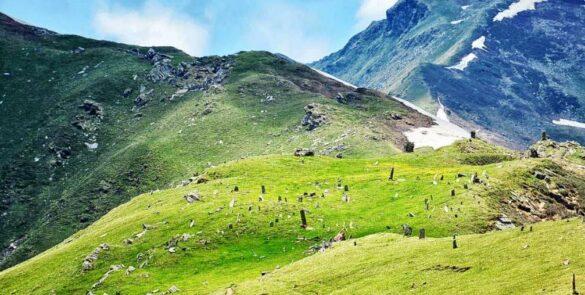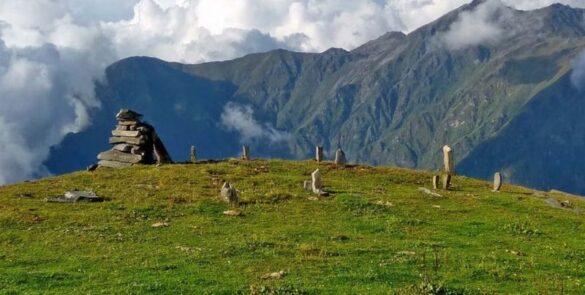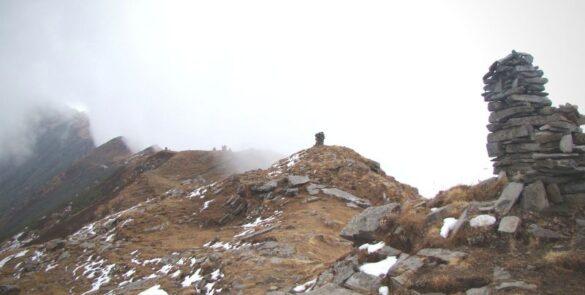Base Camp
Manali
Region
Himachal
Trek Grade
Moderate
Trek Distance
21 Kms
Trek Duration
4 Days
Highest Altitude
12,185 ft
Best Season
June to September
Pick & Drop Point
Manali
Railway Station
Chandigarh
Nearest Airport
Bhuntar
Region
Himachal
Base Camp
Manali
Trek Grade
Moderate
Trek Distance
21 Kms
Trek Duration
4 Days
Highest Altitude
12,185 ft
Best Season
June to September
Railway Station
Chandigarh
Pick & Drop Point
Manali
Nearest Airport
Bhuntar
Contact Us
₹ 12,700
+5% GST
- Transport Included | Manali and return
ABOUT CHANDRAKHANI PASS TREK
Nestled amidst the majestic peaks of the Himalayas in Himachal Pradesh, the Chandrakhani Pass Trek stands as a testament to the allure of mountain exploration. This enchanting trek offers adventurers an opportunity to immerse themselves in the breathtaking beauty of the region while traversing through diverse landscapes and experiencing the rich cultural heritage of the area.

The ideal time to undertake the Chandrakhani Pass trek is from May to October, when the weather is pleasant, and the trails are clear of snow.
The highlight of the trek is crossing the Chandrakhani Pass itself, offering mesmerizing views of the surrounding valleys and mountains.
The journey begins in the charming town of Naggar, a picturesque haven renowned for its ancient temples and traditional architecture. From Naggar, trekkers embark on a quest into the heart of the Himalayas, venturing into the wilderness that surrounds the town.

As the trek unfolds, the trail meanders through verdant forests adorned with oak, pine, and deodar trees, casting dappled shadows upon the path. The air is filled with the melody of chirping birds and the rustle of leaves, creating a serene ambiance that envelops trekkers in tranquility.
Ascending further, trekkers are greeted by the sight of colorful wildflowers carpeting the meadows, painting the landscape with vibrant hues. Each step brings them closer to the snow-capped peaks that loom majestically in the distance, their towering summits serving as a reminder of the awe-inspiring power of nature.
One of the highlights of the Chandrakhani Pass trek is reaching the eponymous pass itself, situated at an altitude of over 3,714 meters above sea level and connects the villages of Malana and Naggar in the Kullu district. Here, trekkers are rewarded with panoramic views of the surrounding mountains, valleys, and meandering rivers, offering a glimpse into the raw beauty of the Himalayan landscape.

As trekkers descend from the pass, they encounter the remote village of Malana, shrouded in myth and mystery. Renowned for its unique culture and ancient traditions, Malana beckons travelers with its intriguing allure, inviting them to delve into its enigmatic past and immerse themselves in its timeless charm.
Throughout the journey, trekkers have the opportunity to interact with local villagers, whose warmth and hospitality leave an indelible mark on the soul. Sharing stories and laughter around the campfire, they forge bonds that transcend language and culture, united by a shared love for the mountains and the spirit of adventure.
The Chandrakhani Pass trek is not merely a physical journey; it is a soul-stirring odyssey that leaves a lasting impression on all who undertake it. It is a testament to the enduring allure of the Himalayas, drawing travelers from far and wide to its rugged terrain and untamed beauty.
As trekkers bid farewell to the mountains and make their way back to civilization, they carry with them memories of a journey filled with awe, wonder, and discovery. For in the heart of the Himalayas, amidst the towering peaks and sweeping valleys, they have found not only adventure but also a profound connection to the natural world and to themselves.

Overall, the Chandrakhani Pass trek offers an unforgettable experience amidst nature’s splendor, cultural richness, and adventure, making it a popular choice among trekking enthusiasts visiting Himachal Pradesh.
FIX DEPARTURE
1st, 2nd, 3rd, 4th, 5th, 6th, 7th, 8th, 9th, 10th, 11th, 12th, 13th, 14th, 15th, 16th, 17th, 18th, 19th, 20th, 21st, 22nd, 23rd, 24th, 25th, 26th, 27th, 28th, 29th, 30th, June.
1st, 2nd, 3rd, 4th, 5th, 6th, 7th, 8th, 9th, 10th, 11th, 12th, 13th, 14th, 15th, 16th, 17th, 18th, 19th, 20th, 21st, 22nd, 23rd, 24th, 25th, 26th, 27th, 28th, 29th, 30th, 31st July.
1st, 2nd, 3rd, 4th, 5th, 6th, 7th, 8th, 9th, 10th, 11th, 12th, 13th, 14th, 15th, 16th, 17th, 18th, 19th, 20th, 21st, 22nd, 23rd, 24th, 25th, 26th, 27th, 28th, 29th, 30th, 31st Aug.
1st, 2nd, 3rd, 4th, 5th, 6th, 7th, 8th, 9th, 10th, 11th, 12th, 13th, 14th, 15th, 16th, 17th, 18th, 19th, 20th, 21st, 22nd, 23rd, 24th, 25th, 26th, 27th, 28th, 29th, 30th Sep.
FAQs
The best time to do the Chandrakhani Pass trek is during the summer months, from June to September, when the weather is generally favorable and the trails are accessible. Avoid trekking during the winter months due to heavy snowfall and adverse weather conditions.
The Chandrakhani Pass trek is considered moderate, with steep ascents, rocky terrain, and high altitude. It requires a reasonable level of fitness and prior trekking experience is recommended, especially for the ascent to Chandrakhani Pass.
Yes, altitude sickness can be a concern, especially during the ascent to Chandrakhani Pass. It's essential to acclimatize properly, stay hydrated, and ascend gradually to minimize the risk of altitude-related illnesses. Trekking with a qualified guide who is trained in managing altitude sickness is advisable.
Essential items to pack include trekking gear (boots, clothing layers), camping equipment (tent, sleeping bag), food and water, first aid kit, sunscreen, sunglasses, headlamp, and personal toiletries. It's important to pack light but ensure you have all the necessary essentials for the trek.
As of the latest information, permits are required for the Chandrakhani Pass trek. It's essential to obtain the necessary permits from the local authorities or trekking agencies before starting the trek. Ensure to check the specific requirements and regulations in place at the time of your trekking expedition.
Accommodation during the trek is primarily camping in tents at designated campsites along the trail. Campsites are basic with minimal facilities, and trekkers are expected to carry their own trekking equipment.
While it's technically possible to do the trek solo, it's recommended to trek with a knowledgeable guide or in a guided group, especially for safety reasons and navigation in remote areas. Having a guide also enhances the overall trekking experience by providing insights into the local culture and environment.
The trek typically starts from Manali, a popular hill station in Himachal Pradesh, India. Manali is well-connected by road from major cities like Delhi and Chandigarh. From Manali, private taxis or local buses are available to reach the trailhead at Rumsu village.
DETAILED ITINERARY
Drive : 27 Km, 2 hours
Trek : 5 km, 4-5 hours
Altitude : 10,400 ft
Depart from Manali early in the morning by road to Rumsu. Arrive at Rumsu, a small village nestled in the mountains, Begin the trek from Rumsu to Naya Tapru. The trail winds through lush forests, offering glimpses of breathtaking mountain vistas. Arrive at Naya Tapru, a beautiful campsite surrounded by meadows, in the afternoon. Set up camp and spend the evening enjoying the serene surroundings. Overnight camping at Naya Tapru.
- Trek:3km,3hour
- Altitude : 11,400 ft
Resume the trek from Naya Tapru to Chaklani after breakfast. Traverse through picturesque landscapes, crossing streams and meadows. Reach Chaklani, another scenic campsite, by late afternoon. Rest and relax at the campsite, soaking in the beauty of the surroundings. Overnight camping at Chaklani.
Trek : 9 km, 7-8 hours
Max Altitude : 12,185 ft
Today is the most challenging day of the trek as you ascend towards Chandrakhani Pass. Start early to avoid any inclement weather conditions. Trek uphill towards Chandrakhani Pass, crossing rocky terrain and snow patches. Reach the summit of Chandrakhani Pass, where you'll be rewarded with panoramic views of the surrounding peaks. Descend carefully towards Nagruni, enjoying the stunning scenery along the way. Arrive at Nagruni campsite by evening. Rest and rejuvenate at the campsite, reflecting on the day's adventure. Overnight camping at Nagruni.
- Trek:4km,3hour
- Drive : 81 km, 3 hours
After breakfast, begin the descent towards Malana village via Magic Valley. Trek through lush forests and charming villages, soaking in the local culture and traditions. Reach Malana village, known for its unique customs and architecture, by afternoon. Explore the village and interact with the locals before continuing the journey. From Malana, drive back to Manali, marking the end of the Chandrakhani Pass trek. Arrive in Manali by evening, concluding the memorable trekking experience.
This itinerary is subject to change based on weather conditions and group preferences.
FIX DEPARTURE
1st, 2nd, 3rd, 4th, 5th, 6th, 7th, 8th, 9th, 10th, 11th, 12th, 13th, 14th, 15th, 16th, 17th, 18th, 19th, 20th, 21st, 22nd, 23rd, 24th, 25th, 26th, 27th, 28th, 29th, 30th, June.
1st, 2nd, 3rd, 4th, 5th, 6th, 7th, 8th, 9th, 10th, 11th, 12th, 13th, 14th, 15th, 16th, 17th, 18th, 19th, 20th, 21st, 22nd, 23rd, 24th, 25th, 26th, 27th, 28th, 29th, 30th, 31st July.
1st, 2nd, 3rd, 4th, 5th, 6th, 7th, 8th, 9th, 10th, 11th, 12th, 13th, 14th, 15th, 16th, 17th, 18th, 19th, 20th, 21st, 22nd, 23rd, 24th, 25th, 26th, 27th, 28th, 29th, 30th, 31st Aug.
1st, 2nd, 3rd, 4th, 5th, 6th, 7th, 8th, 9th, 10th, 11th, 12th, 13th, 14th, 15th, 16th, 17th, 18th, 19th, 20th, 21st, 22nd, 23rd, 24th, 25th, 26th, 27th, 28th, 29th, 30th Sep.
THINGS TO CARRY
BASIC GEARS
- Backpack & Rain Cover (50-70 Litres)
- Hiking bag (20 litre)
- Trekking Shoes (Ankle Shoes)
- Warm clothes
- Water Bottles
CLOTHES
- Jacket (Down or padded)
- Fleece or woolen clothes
- Trek pants and Trousers
- T-shirts (collar and full sleeves)
- Thermal inner wears (both upper and lower)
- Woolen or Fleece cap
- Hand Gloves
- Socks (4 pairs)
- Neck cover, Muffler, Balaclava, any
ACCESSORIES
- Sunglasses
- Sunscreeen Lotion (SPF 50/70)
- Moisturizer and Lip Balm
- Sun cap
- Raincoat and Ponchos
- Power banks
- Trekking pole
- Headlight
OTHERS
- Small Hiking bag (10-20litre) (for summit climb or if you opt to offload your backpack)
- Tiffin box
- Flip flops
- Glucose, Dry fruits
- Personal Toiletries kit
- Toilet paper roll and sanitizer
- Personal basic medical kit
MANDATORY DOCUMENTS
- Original with photocopy of government photo identity card any one (Passport, Aadhaar Card, Driving license or Voter ID)
INCLUSIONS
- Transportation : Manali and return
- Accommodation (Hotel, Homestay, Camping)
- Meals : All Meals as per menu from first day Dinner to last day Breakfast at basecamp; Vegetarian Meal.
- Camping charges : Camping and forest permit fees for Indian Nationals.
- Trekking equipment : High quality tents (living tent- triple sharing, kitchen tent, dinning tent, toilet tent)
EXCLUSIONS
- Meals during road journeys
- Insurance
- Any personal expenses
- Mules or porter to carry personal luggage
- Anything apart from inclusions
Backpack Offloading Charges
• Offload your backpack to a mule or porter to lighten your load during the trek.
• Offloading charges range from ₹300 to ₹900 per day per bag, depending on the specific trek.
• Ensure your backpack weighs less than 11 kg and is equipped with a waterproof cover.
• Suitcases, trolleys, or duffel bags are not allowed.
POLICY
Booking Confirmation Policy
• The customer receives a Booking confirmation receipt immediately via Email and WhatsApp of a successful booking.
Cancellation policy
In the event you cancel your trek, cancellation policy we follow :
• Cancellation 20 days before the starting date of the trek – Refund with 10% cancellation charges.
• Cancellation 10 days before the starting date of the trek – Refund with 50% cancellation charges
• Cancellation less than 10 days from the starting date of the trek – No refund
Note: HA gives you a facility in the event of cancellation due to some reason to transfer your trek (same trek and same batch) to your friend.
REFUND :
• The refund will be given in the form of a trek voucher with 1 year validity, you will get an email for your trek voucher, which will take up to 7 working days.
FAQs
The best time to do the Chandrakhani Pass trek is during the summer months, from June to September, when the weather is generally favorable and the trails are accessible. Avoid trekking during the winter months due to heavy snowfall and adverse weather conditions.
The Chandrakhani Pass trek is considered moderate, with steep ascents, rocky terrain, and high altitude. It requires a reasonable level of fitness and prior trekking experience is recommended, especially for the ascent to Chandrakhani Pass.
Yes, altitude sickness can be a concern, especially during the ascent to Chandrakhani Pass. It's essential to acclimatize properly, stay hydrated, and ascend gradually to minimize the risk of altitude-related illnesses. Trekking with a qualified guide who is trained in managing altitude sickness is advisable.
Essential items to pack include trekking gear (boots, clothing layers), camping equipment (tent, sleeping bag), food and water, first aid kit, sunscreen, sunglasses, headlamp, and personal toiletries. It's important to pack light but ensure you have all the necessary essentials for the trek.
As of the latest information, permits are required for the Chandrakhani Pass trek. It's essential to obtain the necessary permits from the local authorities or trekking agencies before starting the trek. Ensure to check the specific requirements and regulations in place at the time of your trekking expedition.
Accommodation during the trek is primarily camping in tents at designated campsites along the trail. Campsites are basic with minimal facilities, and trekkers are expected to carry their own trekking equipment.
While it's technically possible to do the trek solo, it's recommended to trek with a knowledgeable guide or in a guided group, especially for safety reasons and navigation in remote areas. Having a guide also enhances the overall trekking experience by providing insights into the local culture and environment.
The trek typically starts from Manali, a popular hill station in Himachal Pradesh, India. Manali is well-connected by road from major cities like Delhi and Chandigarh. From Manali, private taxis or local buses are available to reach the trailhead at Rumsu village.





